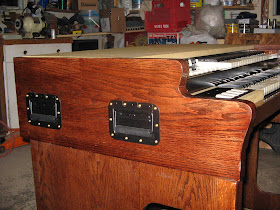The Hammond organ, the most well known classic keyboard of all time. The hammond was poplar in rock, blues, jazz, prog, gospel, funk, and various other genres of music. The most famous of the hammond organs was the B3, commonly played through a leslie rotating speaker, as seen below.

I got intrigued by the idea of owning a real hammond organ, but at $3000 plus, it seemed a little unrealistic. Of course, there are other great sounding hammond organs such as the M3. The M3 is a spinet model commonly referred to as the "baby B3" because of its use of basically identical parts to the B3, minus the 61 note manuals. The advantage to the M3 is of course the price (generally around $100). I started searching craigslist for an M3 and came across on in nonworking condition for 200 bucks. I decided to go take a look at it and found it to be in pretty decent shape. All the tubes warmed up and the start motor worked, but the tone generator just wouldn't spin. I figured this 54 year old instrument should be pretty easy to fix, so I talked the guy down to 80 bucks and took it home. Heres a picture of what it looked like when I brought it home.

After about 5 minutes of tinkering with it, I found that the drive gear on the starter motor was stuck. I moved it a bit with my finger and It worked! Everything worked perfectly and it sounds great! They just don't make stuff like they used to...
See "Rebirth of a classic part II" to see where the project goes from here.
See "Rebirth of a classic part II" to see where the project goes from here.










































